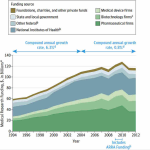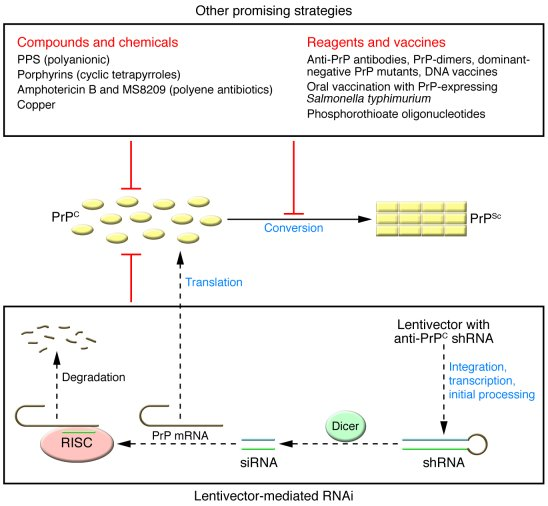Prion disease treatment is at the forefront of groundbreaking research, offering a flicker of hope for individuals affected by these devastating conditions. Prion diseases, such as Creutzfeldt-Jakob disease and fatal familial insomnia, are characterized by the accumulation of misfolded proteins that lead to severe neurological decline. Recent advancements have emerged from the Broad Institute, where a team has pioneered a gene editing approach that targets the prion protein gene, significantly reducing harmful protein levels in laboratory mice and extending their lifespans. This breakthrough in prion research signals potential pathways towards effective therapies that could revolutionize care for these fatal disorders. As researchers continue to navigate the complexities of human trials, the possibility of transformation in prion disease treatment looms ever closer, igniting hope for patients and families suffering from these rare diseases.
The quest for innovative strategies to mitigate the impacts of prion diseases encompasses a wide array of methodologies aimed at combating irreversible brain degeneration caused by abnormal protein folding. Conditions like fatal familial insomnia and Creutzfeldt-Jakob disease highlight the urgent need for effective interventions as they pose formidable challenges to both patients and researchers alike. Recent developments spotlight gene editing technologies that hold promise in silencing the production of toxic proteins, which may reshape the therapeutic landscape for those afflicted. As scientists venture into this uncharted territory, each advancement represents a significant step toward identifying viable solutions for addressing these debilitating disorders. Alongside a dedicated community of researchers and patient-advocates, this journey unfolds with the hope of uncovering the keys to better lives for individuals touched by prion-related ailments.
Breakthroughs in Prion Disease Research
In recent years, prion disease research has experienced groundbreaking advancements, offering a glimmer of hope for patients and their families. The latest findings by researchers at the Broad Institute reveal that a simple alteration in the prion protein gene can halve the toxic protein levels in laboratory mice’s brains. This landmark study not only extends the lifespan of these mice by 52% but also lays the groundwork for developing potential treatments for disorders like Creutzfeldt-Jakob disease and fatal familial insomnia. These advancements are becoming increasingly crucial as the scientific community works towards unraveling the complexities of prion diseases.
The collaborative efforts of dedicated researchers and patient-scientists have been pivotal to achieving these milestones. With each experiment, new insights emerge about the mechanisms that drive these devastating disorders. As researchers explore gene editing techniques, including those pioneered by David Liu, the potential for effective therapies becomes more attainable. This synergy of personal experience and scientific rigor exemplifies the urgency and passion driving prion disease research forward.
The Role of Gene Editing in Prion Disease Treatment
Gene editing has emerged as a revolutionary approach in the quest for effective prion disease treatment. By employing cutting-edge technologies such as base editing, researchers are able to make precise modifications to the prion protein gene, which is instrumental in the progression of disorders like Creutzfeldt-Jakob disease. This targeted approach allows for a reduction in the production of misfolded proteins that cause neurodegeneration, which has shown promise not only in preliminary animal studies but also paves the way for potential future human trials.
One significant aspect of this research is its potential implications for hereditary forms of prion diseases, such as fatal familial insomnia. With approximately 15% of cases stemming from inherited mutations, gene editing offers a path towards personalized medicine, where treatments can be tailored to the genetic background of affected individuals. The ongoing studies embody a crucial effort to harness gene editing as a means of altering the disease trajectory and improving patient outcomes.
Understanding Prion Diseases: A Closer Look
Prion diseases are a group of neuropathological conditions marked by the induced misfolding of normal proteins into infectious forms, leading to severe cognitive impairment and ultimately death. The most well-known of these disorders is Creutzfeldt-Jakob disease, along with other variants such as Gerstmann-Sträussler-Scheinker disease. Each of these conditions poses unique challenges in diagnosis and treatment, underscoring the need for comprehensive research and innovative therapies.
Current understanding indicates that the vast majority of prion cases arise sporadically, but genetic predispositions in certain individuals can exacerbate the risks. By studying the underlying mechanisms of these diseases, researchers can identify critical intervention points where treatment, such as gene-editing therapies, may halt the progression of the disease. This deepening knowledge of prion diseases is vital not only for scientists but also for families affected by these debilitating conditions.
Personal Impact of Prion Disease: Stories of Hope
The narrative of Sonia Vallabh and Eric Minikel exemplifies the personal nature of prion disease research. After losing Vallabh’s mother to fatal familial insomnia and her subsequent diagnosis, the couple dedicated their lives to finding effective treatments for prion diseases. Their story highlights how personal experiences can fuel scientific inquiry and innovation, motivating researchers to push the boundaries of what is possible in the realm of genetic therapies.
Their commitment illustrates the intersection of patient urgency and scientific discovery, creating a partnership that not only aims to advance research but also transforms the landscape of treatment for individuals living with prion diseases. Through their advocacy and work at the Broad Institute, they inspire hope not only within the scientific community but also among patients and families grappling with these life-altering conditions.
Challenges Ahead in Treating Prion Diseases
Despite the promising advancements in prion disease research, significant challenges remain before these breakthroughs can translate into clinical applications. One of the primary hurdles lies in the complexity of the diseases themselves, which necessitate rigorous testing and validation processes before any potential treatment can reach the human trial stages. As highlighted by David Liu, while current results are encouraging, the path to effective therapies is long and filled with regulatory and scientific obstacles that must be navigated carefully.
Moreover, the infectious nature of prions presents unique safety concerns in experimental research. The accidental exposure that led to a researcher’s death underscores the critical need for strict protocols and innovative methods to mitigate risks long associated with prion studies. Researchers must continuously adapt their approaches, ensuring that safety in pursuit of scientific knowledge remains a top priority.
Collaborative Efforts in Prion Disease Research
The collaborative nature of prion disease research has proven essential in accelerating discoveries and advancements in treatment options. Teams of researchers from diverse backgrounds, including neurology, genetics, and bioengineering, come together to share insights, resources, and innovative strategies aimed at tackling these complex disorders. Collaboration maximizes expertise, enhancing the probability of successful outcomes in experimental studies.
For instance, the partnership between Vallabh, Minikel, and Liu has facilitated an environment of shared knowledge and mutual motivation. Their experience exemplifies how interdisciplinary collaboration can shape the future of treating rare diseases, ensuring that patient needs and scientific integrity remain at the forefront of their research efforts. This teamwork not only fosters significant findings but also inspires a broader community engaged in battling the challenges posed by prion diseases.
Future Directions in Prion Disease Therapy
As research continues to evolve, the future of prion disease therapy remains optimistic yet cautious. With promising results emerging from gene editing studies, scientists are exploring various methodologies to refine and enhance the efficacy of these treatments. Efforts are being channeled into optimizing delivery mechanisms for therapeutic agents to ensure targeted action within the brain while reducing potential adverse effects.
Anticipating the future of prion disease treatment also requires an understanding of the genetic factors at play. Continuing to investigate the prion protein gene and its mutations will be crucial in tailoring therapies to individuals, moving us closer to personalized medicine. Researchers are poised to push the envelope on how we treat these persistent challenges, bringing hope to those affected by prion diseases.
The Importance of Public Awareness in Prion Disease Research
Raising public awareness regarding prion diseases and their implications is vital for fostering support and funding for ongoing research efforts. Awareness campaigns can highlight stories of affected families, such as that of Vallabh and Minikel, emphasizing the urgent need for advances in treatment and research. Increased visibility can stimulate interest in scientific research and encourage private and public funding sources to invest in promising therapeutic developments.
Moreover, public understanding of the complexities of prion diseases can lead to improved healthcare policies and ethical considerations in research practices. Educating stakeholders about the impact of genetic mutations and the importance of collaboration within the scientific community can create a solid foundation for building partnerships, leading to more significant breakthroughs in treating these rare and fatal conditions.
Ethical Considerations in Prion Disease Research
The advancements in genetic therapies for prion diseases raise important ethical considerations about the use of gene editing technologies. As researchers delve into modifying genetic expressions, questions about consent, the implications of altering the human genome, and the long-term effects on patients and future generations become paramount. These discussions must be at the forefront of prion disease research, ensuring that ethical standards are upheld.
Additionally, balancing the urgency of developing new treatments with the thoroughness required for safe and effective therapies is crucial. Engaging the public and stakeholders in conversations about the ethical implications can foster transparency and trust in scientific endeavors, creating a more supportive environment for research activities. By addressing these ethical considerations, the scientific community can ensure responsible progress in the development of prion disease treatments.
Frequently Asked Questions
What recent advancements have been made in prion disease treatment?
Recent research has made significant strides in prion disease treatment through the development of a promising gene-editing therapy. This therapy, which targets the prion protein gene responsible for conditions like Creutzfeldt-Jakob disease and fatal familial insomnia, has shown a 52 percent extension in the lifespan of laboratory mice by halving the production of misfolded prion proteins in their brains.
How does gene editing help combat prion diseases like fatal familial insomnia?
Gene editing, particularly through techniques developed at the Broad Institute, is a key focus in prion disease treatment. By altering a single base in the prion protein gene, researchers have demonstrated that it’s possible to significantly reduce toxic protein levels in the brain, which could ultimately lead to effective treatments for diseases such as fatal familial insomnia.
What is the role of the prion protein gene in prion disease treatment?
The prion protein gene is central to prion diseases since mutations or misfolded proteins derived from this gene can lead to conditions like Creutzfeldt-Jakob disease. Advances in gene editing are targeting this gene to block the production of harmful proteins, presenting a potential breakthrough in prion disease treatment.
Are there clinical trials planned for prion disease treatments developed from recent research?
While promising research has been published regarding gene editing in prion disease treatment, human clinical trials are still a ways off. Researchers are cautious, recognizing that multiple steps must be taken before these novel treatments can be tested in humans, due to the complexities involving prion diseases.
What unique perspectives do patient-scientists bring to prion disease research?
Patient-scientists, like Sonia Vallabh and Eric Minikel, provide personal motivation and firsthand experience with prion diseases such as fatal familial insomnia. Their involvement bridges the gap between laboratory research and patient treatment needs, driving a dedicated effort to develop viable therapies and contributing crucial insights into the research process.
| Key Points | Details |
|---|---|
| Treatment Development | Gene-editing therapy shows promise for treating prion diseases. |
| Prion Disease Overview | Group of fatal disorders caused by misfolded brain proteins. |
| Research Findings | Base editing can reduce harmful protein levels and extend lifespan in mice by 52%. |
| Collaborative Effort | Researchers include patient-scientists who have a personal connection to prion disease. |
| Future Steps | Multiple steps required before human trials, including refining technology and improving safety. |
Summary
Prion disease treatment is moving forward as researchers develop innovative gene-editing therapies that demonstrate significant potential. With promising laboratory results indicating the ability to reduce harmful protein levels in the brain, the hope is that these advancements could lead to effective therapies for a group of diseases that currently have no cure. The personal stakes involved for the researchers, including patient-scientists affected by prion disease, add a compelling urgency to the effort, making the pursuit of a treatment not just a scientific endeavor but a heartfelt mission.
















